What is the average house size in the UK?
Houses are a controversial subject in the UK. Some say we are not building enough, some say we are not building houses of the right quality and some say the houses we are building are just too small.
Now, while the first two complaints are generally quite subjective topics, where the argument largely rests on your opinion, you simply can’t argue with size.
Either the British houses we are building are smaller than the previous decade, or they are not. Simple, data-led fact.
With this in mind, the data experts at LABC Warranty wanted to settle the argument once and for all - are Britain’s houses really getting smaller?
Turning to property sites such as Rightmove and Zoopla, we have analysed data on 10,000 houses built in each decade going all the way back to the 1930s.
Find our results below - and yes, Britain’s houses really are getting smaller!
Find a full methodology at the bottom of this article.
Average UK house size in the 1930s
Going back to the 1930s, this is where our analysis starts.
You may be wondering:
“Why start in the 1930s?”
Well, unfortunately there just isn’t enough data for houses built in the decades before 1930. Whether they have been knocked down to make way for new housing developments or turned into student accommodation, there simply weren’t 10,000 houses available for us to analyse.
So what did LABC Warranty’s analysis of 1930s houses show?
Britain’s 1930s houses really were quite small. The analysis showed that the average living room would measure about 16.01m2 and the main bedroom was on average 15.34m2. 1930s kitchens were the smallest of any decade, with the average measuring just 12.27m2.
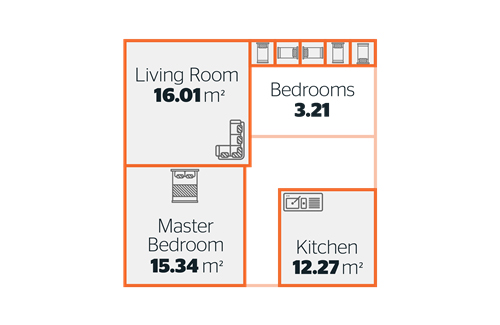
Key Stats - 1930s Housing
The average living room was 16.01m2
The average master bedroom was 15.34m2
The average kitchen was 12.27m2
The average home had 3.21 bedrooms
Average UK house size in the 1940s
The Second World War had a profound impact on the British building industry.
Much of the industry came to a standstill in the first half of the decade, while the second half was plagued by a short supply of workers and building materials.
So what did their analysis of 1940s houses show?
Of the housing that was built after the war, things did start to improve. Living rooms grew by 1.12m2 and kitchen size grew by nearly 2.00m2. That’s quite an improvement across the decade.
However, their analysis did show that master bedroom size decreased by over 1.5m2. This could be the direct result of 40s houses offering more bedrooms than the previous decade.
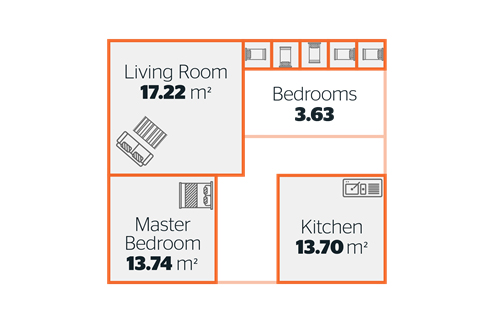
Key Stats - 1940s Housing
The average living room was 17.22m2
The average master bedroom was 13.74m2
The average kitchen was 13.70m2
The average home had 3.63 bedrooms
Average UK house size in the 1950s
Following the Second World War, the desire to rebuild the nation was paramount.
People demanded new homes and the need to rebuild such a great number of homes led to a housing revolution.
So what did LABC Warranty’s analysis of 1950s houses show?
In terms of the size, houses built in the 1950s offered plenty.
Our analysis showed that living rooms grew even further to 22.03m2. Kitchen size grew by another 0.30m2, and the master bedroom added nearly 1m2 to its overall size.
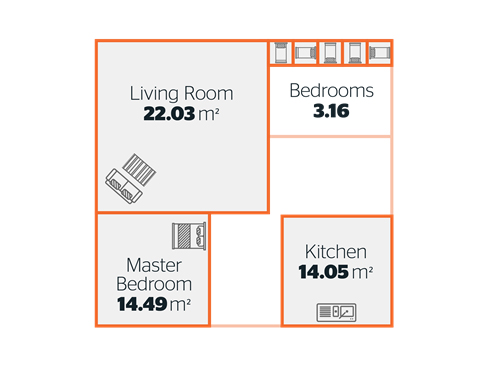
Key Stats - 1950s Housing
The average living room was 22.03m2
The average master bedroom was 14.49m2
The average kitchen was 14.05m2
The average home had 3.16 bedrooms
Average UK house size in the 1960s
The 1960s house building industry was split into two eras.
The first was between 1960 and 1965. For five years the industry embraced the construction of tower block housing, with over 55,000 built in 5 years.
The second half of the 60s saw complaints of shoddy design overwhelm the building industry. This led to tower blocks being dropped in exchange for functional, box-like homes that are highly popular today.
So what did analysis of 1960s houses show?
As the quality of Britain’s homes improved in the later part of the decade, so did the size.
Living rooms remained over 20m2 and master bedrooms had a 15.05m2 average. The largest so far.
Interestingly, our analysis showed that on average 1960s houses were 1.35m2 bigger than the previous decade.
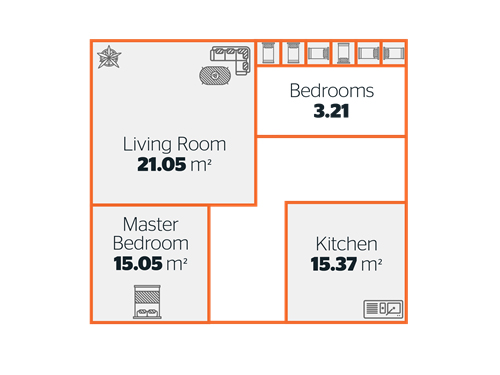
Key Stats - 1960s Housing
The average living room was 21.05m2
The average master bedroom was 15.05m2
The average kitchen was 15.37m2
The average home had 3.21 bedrooms
Average UK house size in the 1970s
With inflation as high as 36% defining the first half of the 70s, the second half of the decade would be defined by modern architecture.
Homes started to move away from traditional box-like design and almost took on a whimsical appeal.
So what did the analysis of 1970s houses show?
As houses started to take on whimsical interior design, the exterior size of the average house continued to grow.
Living rooms reached 24.89m2, the typical kitchen measured 14.96m2 and the average number of bedrooms grew to 3.53.
Overall, Britain built the biggest houses in the 1970s.
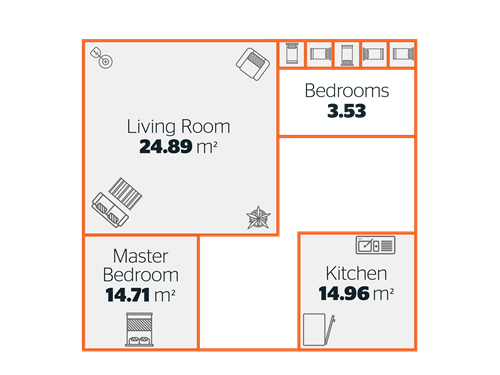
Key Stats - 1970s Housing
The average living room was 24.89m2
The average master bedroom was 14.71m2
The average kitchen was 14.96m2
The average home had 3.53 bedrooms
Average UK house size in the 1980s
As disposable income nearly doubled in the 80s, the demand for improved regulations and guidelines for new housing developments soared.
This led to a decline in the number of houses being built, but the quality surged.
So what did their analysis of 1980s houses show?
Britain’s houses started to regress.
Living room size dropped by an average of 2.8m2, master bedroom size dropped from 14.71m2 to 13.83m2 and even typical kitchen sizes regressed by 0.82m2.
Does this downhill trend continue?
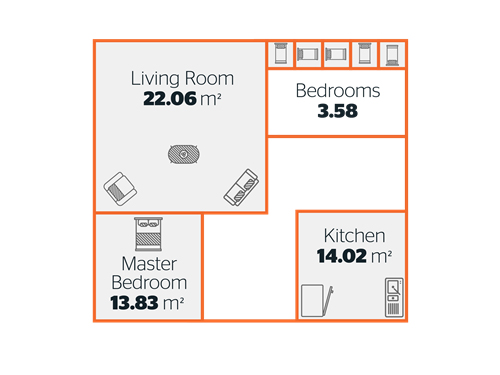
Key Stats - 1980s Housing
The average living room was 22.06m2
The average master bedroom was 13.83m2
The average kitchen was 14.02m2
The average home had 3.58 bedrooms
Average UK house size in the 1990s
The last decade of the 20th century will be remembered as the era that celeb culture emerged, reality TV was born and glossy magazines aplenty could be found in most UK homes.
So what did LABC Warranty’s analysis of 1990s houses show?
Similar to the previous decade, Britain’s houses would continue to get smaller.
Living rooms would regress by 0.7m2 and kitchens would lose another 0.25m2 also.
Surprisingly, master bedrooms did make a slight improvement of 0.12m2 compared to the previous decade.
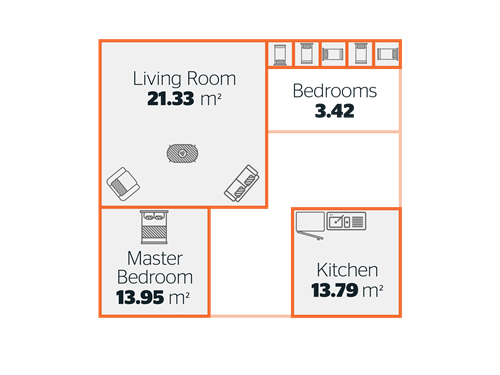
Key Stats - 1990s Housing
The average living room was 21.33m2
The average master bedroom was 13.95m2
The average kitchen was 13.79m2
The average home had 3.42 bedrooms
Average UK house size in the 2000s
With the turn of the millennium, British society was blown away by the advances in technology and science.
The iPod would change how we listened to music forever.
Social networking would take over our lives.
Recycling bins would become a ‘thing’.
So what did analysis of 2000s houses show?
Compared to the previous two decades, Britain’s houses would continue to get smaller.
Our analysis showed that the average living room size dropped to below 20m2 for the first time in 50 years, while the master bedroom and kitchen would regress too.
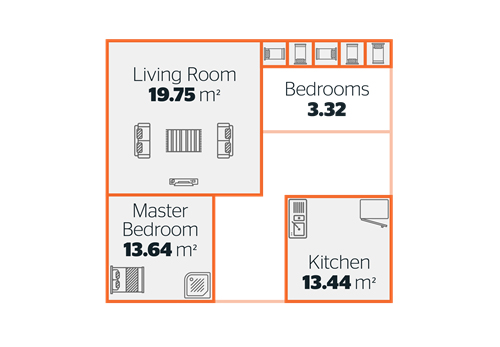
Key Stats - 2000 Housing
The average living room was 19.75m2
The average master bedroom was 13.64m2
The average kitchen was 13.44m2
The average home had 3.32 bedrooms
So what is the UK's average house size overall?
Today, Britain’s houses have never been smaller.
LABC Warranty’s analysis of the first seven years of the decade is continued regression.
The average living room is now 17.09m2. That’s a 1.64m2 drop in a decade. Bedroom size and the number of bedrooms on offer has decreased also.
Master bedrooms diminish by an average of 0.30m2 and the number of bedrooms dropped to below three for the first time ever.
The overall statistics don’t make for pretty reading either. Compared to the previous decade, homes built from 2010 onwards are over 4m2 smaller.
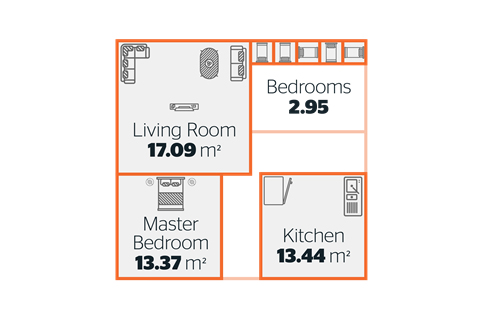
Key Stats - Current Housing
The average living room is 17.09m2
The average master bedroom is 13.37m2
The average kitchen is 13.44m2
The average home has 2.95 bedrooms
Living Room
Bedroom
Master Bedroom
Kitchen
Overall - Updated
This graph was updated on April 10th, 2018 at 10:20am. A user pointed out a small error in our calculations. Please find the revised figures in the graphic below.
Please keep in mind that our overall analysis is a total of the living room, kitchen, master bedroom, secondary bedroom, third bedroom and bathroom. This does not include hallways, stairs etc.
Methodology
All statistics that feature in this article have been collated using open data from property sites Rightmove and Zoopla. The study looked at 10,000 houses built in the 1930s, 1940s, 1950s, 1960s, 1970s, 1980s, 1990s, 2000s and the current decade. Data was taken on individual rooms within a home. All statistics are calculated on average.
(This article first appeared on the LABC Warranty website.)
Also read
Building regulations approval still needed for house extensions
Sign up to the building bulletin newsletter
Over 48,000 construction professionals have already signed up for the LABC Building Bulletin.
Join them and receive useful tips, practical technical information and industry news by email once every 6 weeks.
Subscribe to the Building Bulletin

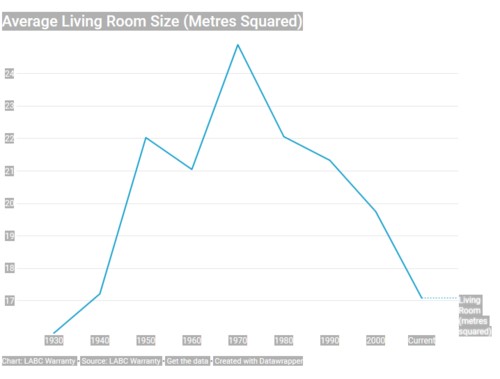
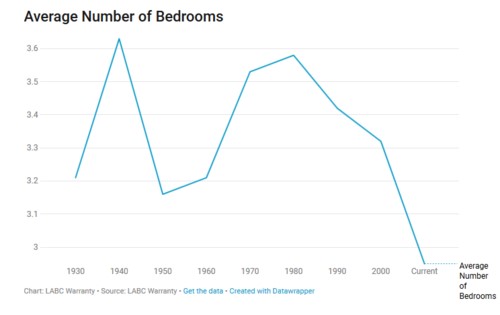
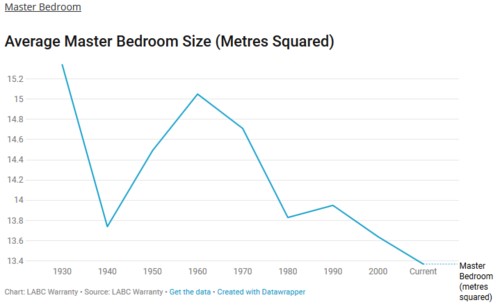
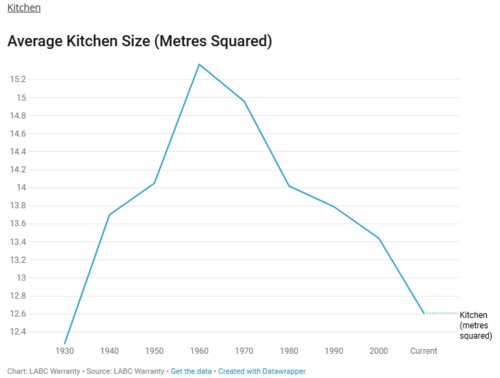
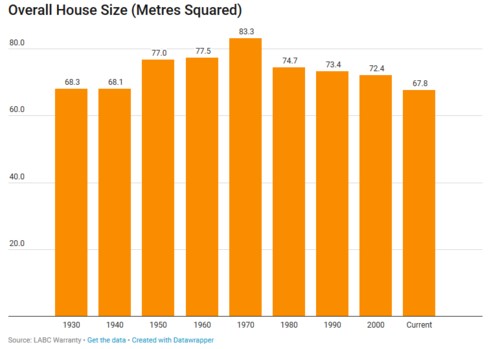

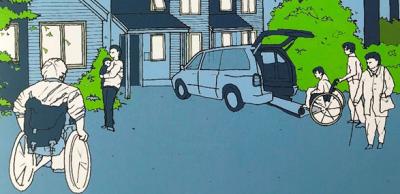

Comments
overall size of residential dwellings
Submitted 5 years 11 months ago
Comparison or listing the size of a house in the number of "bed rooms" (in the UK more a room where a bed fits and nothing else) is almost as useful as classifying a car by the number of seats.
This is particularly important as often dwellings are built as houses rather than flats, so in addition to tiny rooms you also lose floorspace to stairways/corridors, etc.
Additionally, by looking at your Key Stats - Current Housing only
The average living room is 17.09m2
The average master bedroom is 13.37m2
The average kitchen is 13.44m2
The average home has 2.95 bedrooms
you also miss important information such as storage space, which is also quite essential.
Reply
Submitted 5 years ago
(No subject)
Submitted 4 years 11 months ago
House
Submitted 4 years 4 months ago
Useful
Submitted 4 years 2 months ago
Bias because of house demolition?
Submitted 4 years 1 month ago
However, the data only covers houses that still exist and are not in public ownership. Any house that was built, but subsequently demolished, does not figure in the calculations. Neither do houses built by public bodies for rent. If, as seems possible, any properties demolished are more likely to have been the smaller, cheaper ones, the average size of houses from earlier decades would be underestimated.
(No subject)
Submitted 2 years 7 months ago
LABC Response
Submitted 2 years 7 months ago
Kind Regards,
LABC Team
Political Happenings
Submitted 1 year 11 months ago
1) If one looks at this as a sort of 'work-in-progress', then I think it is a very good start. One has, in anything, to start somewhere. There can be improvements later. Let's hope that this page carries on.
2) There is no mention of 'politics'. As far as I understand it, at one time there were standards for house and room size. These standards were swept away by the Tory administration and an insistence that "The market will decide (on the sizes and standards)".
I went, once, to 'view' a house. It was an unremarkable 1970s style house in a small group with others of similar style. On entering I was struck by how spacious it was, by comparison with the other houses we had been 'viewing'. Then it struck me; the house had been built as a council house to the 'old' standards. That's why it was so spacious.
3) A comparison with houses in other European countries, such as France and Germany would also be very interesting.
LABC response
Submitted 1 year 11 months ago
Thank you for your comment.
Best,
LABC team
Ychwanegu sylw newydd